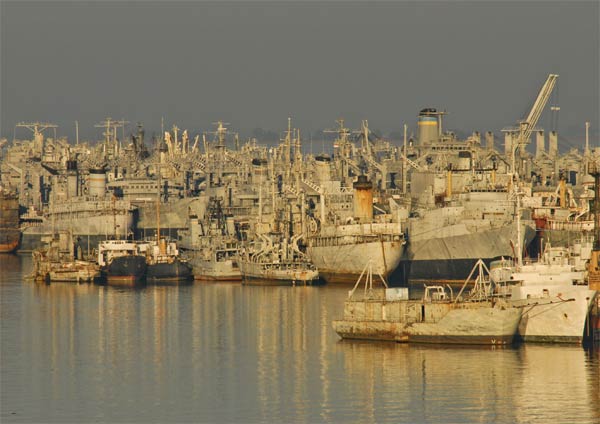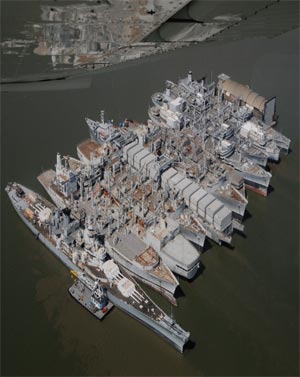
Travelers driving north across the Martinez Bridge are treated to an unusual sight upriver. A number of gray ships, moored abreast in several rows about a mile east of the bridge, patiently await their fate. These ships are commonly referred to by the public as the “mothball fleet.”
Immediately following the end of World War II, Congress voted to establish a National Defense Reserve Fleet (NDRF) to serve as a reserve cadre of ships for national defense and national emergencies. The Maritime Administration (MARAD) maintains this fleet so it can provide surge sealift capability whenever required. MARAD is also responsible for disposing of reserve ships, and other non-combatant Government ships, as they become obsolete.
At its height in 1950, the NDRF (aka “mothball fleet” or “ghost fleet”) consisted of 2,277 ships kept at one of eight anchorages around the U.S. Over time, the NDRF has dwindled to just three anchorages: Fort Eustis, Virginia, Beaumont, Texas, and Suisun Bay in Benicia, California. As of March 31, 2011, there were only 183 vessels left, primarily dry cargo ships along with some tankers and military auxiliaries.
In 1976, an additional Ready Reserve Fleet component was established to provide rapid deployment of military equipment. The Ready Reserve Fleet comprises 48 vessels, some of which are kept with the “mothball” fleet. An additional 28 non-NDRF ships are held in storage for other government agencies. The Suisun Bay fleet contains all of these various categories of ships. For instance, the WWII battleship USS Iowa languishes in row “G” on a donation hold from the Navy until it becomes a museum in California.
Since 1950, NDRF vessels have supported emergency shipping operations during war and national emergencies. During the Korean War, 540 vessels were activated to support the military forces. During the Vietnam War, 172 vessels were activated to support military operations in southeast Asia. More than seventy-five percent of the RRF ships provided support to the U.S. effort’s in the Persian Gulf between August 1990 and April 1991.
In 2005, the Federal Emergency Management Agency (FEMA) used five RRF and four NDRF ships for relief operations in the aftermath of hurricanes Katrina and Rita. The ships provided messing and berthing functions for refinery workers, oil spill response teams, and longshoremen, providing about 83,000 berthing nights and serving roughly 270,000 meals.
MARAD activated six vessels in response to the devastating earthquake that struck Haiti in January of 2010. Three of the six vessels played a direct role in the relief efforts, with two providing logistical support from Port au Prince’s harbor. Another operated as a high speed freight and passenger shuttle between the continental U.S. and Port au Prince.

In addition to maintaining a fleet of active and inactive ships, MARAD is the government’s disposal agent for Federally-owned obsolete, merchant-type vessels, and naval auxiliaries that are equal to or greater than 1,500 gross tons. MARAD disposes of vessels through a variety of methods including domestic recycling and sinking for use as artificial reefs. Due to environmental concerns, the disposal process has been accelerated over the past two years. Of the 72 non-retention vessels currently in the NDRF, 60 are in the disposal process or are ready for disposal and 12 are being reviewed for their historical significance.
By 2017, only a few Ready Reserve Fleet ships will remain in the Suisun Bay fleet.
Suisun Bay Fleet – USS Hassayampa
Many of the ships in the Suisun Bay NDRF have made significant contributions to American history, often behind the scenes rather than in the headlines. July 2011 is the 42nd anniversary of the epic Apollo 11 flight to the moon. So it is fitting for this article to focus on a key contributor in the recovery of that first lunar landing flight.
In the early 1950’s, the U.S. Navy needed combat logistics ships fast enough to keep up with aircraft carrier task forces but with the cargo capacity to provision all the ships of that group. To accomplish this, the Navy created the Neosho class fleet oiler. Their mission was to transport bulk petroleum products, minor freight, mail and personnel from shore depots to these forces at-sea, and effect delivery to them while underway. The term for this latter operation is “underway replenishment” or “UNREP” for short. While logistics support is not considered a glorious mission, it is the cornerstone that allows combat forces afloat to maintain peak readiness and efficiency.
Navy fleet oilers are historically named after American Rivers bearing Indian names. The third Neosho-class ship built (of six total) was named USS Hassayampa (AO-145) after an interesting and historical river in Arizona. The river begins just south of Prescott, flows south through Wickenburg and empties into the Gila River. Except during the rainy winter season, the river bed is dry but the water keeps flowing via an underground channel.
Hassayampa was built in Camden, N.J. and launched in 1954. The vessel is 655 feet long, has a 38,000 ton displacement and can carry over 7.5 million gallons of petroleum products including naval special fuel oil (for ships), aviation gas (for helicopters and propeller aircraft) and jet fuel (for high performance jet aircraft). She was commissioned at the Philadelphia Naval Yard on April 19, 1955 with Senator Barry Goldwater proving the primary remarks at the ceremony.
Hassayampa served 23 years in the “regular” Navy with her home port in Pearl Harbor as part of the Pacific Fleet. From 1955 until 1964 she made many cruises to the Western Pacific and the Indian Ocean. During the Tonkin Gulf crisis in August 1964, which jump started the Vietnam War, Hassayampa supported ships of the Navy’s Pacific and Seventh Fleets in that area. She was recognized for being involved with fourteen naval campaigns during the Vietnam War. In one astonishing two-week period in November 1966, Hassayampa refueled 67 ships!
In July 1969, she was a member of Task Force 130, the small group of ships assigned to recover the Apollo 11 spaceflight. On July 22, forty hours before splashdown, Hassayampa refueled the primary recovery ship USS Hornet in the designated landing area 1,200 miles southwest of Honolulu. The next day, a large storm system affected the area, forcing NASA to move the target site 240 miles northeast. Thanks to the refueling, Hornet was able to steam through the night at high speed and was in position when the Apollo spacecraft splashed down early the next morning. In November 1969, Hassayampa was at it again, refueling Hornet the day before Apollo 12 splashed down in the mid-Pacific.

In 1978, she was decommissioned from the Navy and transferred to the Military Sealift Command (MSC) as the USNS Hassayampa (T-AO 145). Based in Sasebo, Japan as the “duty oiler” in the Far East, it was not uncommon for the ship and its civilian crew to ride out a dozen typhoons every year. In addition to her national defense duties, she handled many special missions. These include the 1983 search and salvage mission associated with Korean Airlines Flight 007 that was shot down by the Russian military. In 1990 and 1991, she was a key member of the naval forces executing the Desert Shield and Desert Storm operations in the Persian Gulf.
In October 1991, Hassayampa was placed out of service by MSC. Spanning her career with the Navy and MSC, she was the most decorated fleet oiler in U.S. history. In May 1999, title to the ship was transferred to MARAD who placed her into the NDRF in Suisun Bay. As ships are slowly withdrawn from that fleet now, only time will tell what the ultimate fate of the “Humpin’ Hass” will be. Her former crewmen are hopeful she will become an artificial reef rather than being cut up for scrap.
San Ramon Valley residents who are interested in the Apollo 11 recovery or in gaining further knowledge of fleet oilers or the mothball fleet, have a unique opportunity the weekend of July 23/24. On Saturday the 23rd, the Hornet Museum in Alameda will be commemorating the anniversary of the Apollo 11 recovery with special guests and activities. On Sunday the 24th, the SS Jeremiah O’Brien in San Francisco will hold one of its rare “Ghost Fleet” tours with a cruise to the NDRF in Suisun Bay. O’Brien’s Master Pat Moloney was the longest serving commander of the USNS Hassayampa and is willing to share his wealth of knowledge with anyone who asks







